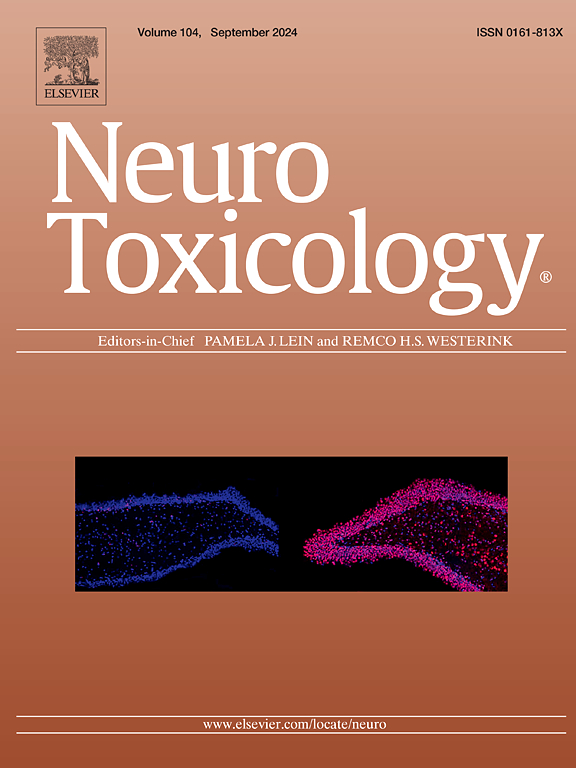口服妊娠期颗粒物10暴露的影响:对神经发育里程碑、抑制控制、成人社交能力和物体识别的见解
IF 3.9
3区 医学
Q2 NEUROSCIENCES
引用次数: 0
摘要
空气污染物与各种神经发育障碍有关,有几项研究特别指出,接触微粒物质(PM)与注意力和社交障碍有关。这种联系在产前接触时更为明显,因为它会破坏正常的大脑发育。然而,虽然对青春期的社交障碍进行了广泛的研究,但其对成人社交行为的影响在很大程度上仍未得到探讨。为了研究这些影响,怀孕的 Wistar 大鼠在整个妊娠期(GD1-GD21)都暴露在 PM10 中,剂量为 200 μg/Kg/ 天,稀释在自由饮用的 PBS 中。幼鼠出生后,对其体重增长、眼球睁开和肌肉力量等发育里程碑进行评估。成年后,使用五选连贯反应时间任务(5-CSRTT)评估抑制控制能力,使用三腔克劳利测试(3-CT)评估社交行为,使用新奇物体识别测试(NOR)评估物体识别能力。结果表明,产前接触 PM10 与出生体重增加和神经肌肉测试表现较差有关。但是,在抑制控制(5-CSRTT)和社会行为(3-CT)方面没有观察到明显的差异。有趣的是,产前暴露的啮齿动物在NOR测试中表现出更强的新奇反应。总之,妊娠期暴露于 PM10 与神经发育里程碑的差异有关,包括体重和肌肉力量。虽然它不会影响成年后的抑制控制或社会行为,但会影响以后的新奇事物识别。本文章由计算机程序翻译,如有差异,请以英文原文为准。
The effects of oral gestational particulate matter 10 exposure: Insights into neurodevelopmental milestones, inhibitory control, adult sociability, and object recognition
Air pollutants have been associated with various neurodevelopmental disorders, with several studies specifically linking Particulate Matter (PM) exposure to attentional and social deficits. This link is even more pronounced when exposure occurs during the prenatal period, as it can disrupt normal brain development. However, while social deficits have been extensively studied during adolescence, their impact on adult social behaviors remains largely unexplored. To investigate these effects, pregnant Wistar rats were exposed throughout gestation (GD1-GD21) to PM10 at a dosage of 200 μg/Kg/day diluted in PBS that was freely drunk. After birth, the pups were evaluated on developmental milestones such as weight progression, ocular opening, and muscular strength. In adulthood, inhibitory control was assessed using the Five Choice Serial Reaction Time Task (5-CSRTT), social behavior using the Three-Chambered Crawley’s Test (3-CT), and object recognition using the Novelty Object Recognition test (NOR). The results indicated that prenatal PM10 exposure is associated with higher birth weight and poorer performance in neuromuscular tests. However, no significant differences were observed in inhibitory control (5-CSRTT) or social behavior (3-CT). Interestingly, prenatally exposed rodents showed heightened novelty responses in the NOR test. In conclusion, gestational exposure to PM10 is related to differences in neurodevelopmental milestones, including weight and muscular strength. While it does not impact adult inhibitory control or social behavior, it influences novelty recognition in later life.
求助全文
通过发布文献求助,成功后即可免费获取论文全文。
去求助
来源期刊

Neurotoxicology
医学-毒理学
CiteScore
6.80
自引率
5.90%
发文量
161
审稿时长
70 days
期刊介绍:
NeuroToxicology specializes in publishing the best peer-reviewed original research papers dealing with the effects of toxic substances on the nervous system of humans and experimental animals of all ages. The Journal emphasizes papers dealing with the neurotoxic effects of environmentally significant chemical hazards, manufactured drugs and naturally occurring compounds.
 求助内容:
求助内容: 应助结果提醒方式:
应助结果提醒方式:


